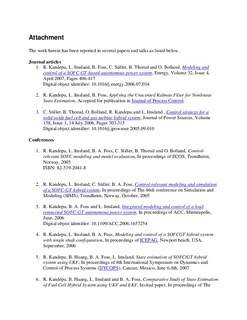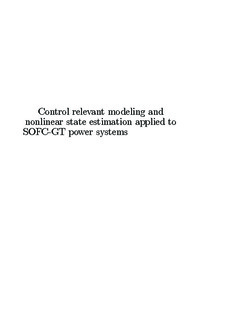| dc.contributor.author | Kandepu, Rambabu | nb_NO |
| dc.date.accessioned | 2014-12-19T14:00:53Z | |
| dc.date.available | 2014-12-19T14:00:53Z | |
| dc.date.created | 2008-01-04 | nb_NO |
| dc.date.issued | 2007 | nb_NO |
| dc.identifier | 123162 | nb_NO |
| dc.identifier.isbn | 978-82-471-3781-9 | nb_NO |
| dc.identifier.uri | http://hdl.handle.net/11250/259417 | |
| dc.description.abstract | With today’s increasing concern about global warming and climate change and further increase in energy demand, there is an incentive to investigate power processes that operate efficiently, and thus reducing the amount of emitted pollutants per produced energy unit. It is widely accepted that fuel cells are power sources that will become increasingly important, due to high efficiency, low levels of pollution and noise, and high reliability. A fuel cell converts chemical energy in a fuel directly to electrical energy without direct combustion. One of the most promising fuel cell technologies is the Solid Oxide Fuel Cell (SOFC), due to its solid state design and internal reforming of gaseous fuels, in addition to its high efficiency. Since SOFCs operate at high temperatures (about 1000◦C), natural gas can be used directly as fuel. The electrical efficiency of a SOFC can reach 55%. Another significant advantage of the SOFC is that since it operates at high temperature and its efficiency increases when pressurized, it naturally lends itself as a heat source for a gas turbine (GT) cycle. The combined (hybrid) cycle can theoretically have an overall electrical efficiency of up to 70% with a power range from a few hundred kWs to a few MWs. The main applications of the hybrid system include remote area power supply and distributed power generation.
To understand the process dynamics and further to design a control structure, it is useful to have a control relevant model of the hybrid system. The first part of the thesis focuses on developing control relevant models of all the components of the SOFC-GT hybrid system using first principles. The SOFC model developed is tested against a very detailed model and the results show that the control relevant model captures the dynamics of the process and thus can be used to design a control structure. Next, a regulatory controller is designed in order for the hybrid system to be able to follow the dynamic load changes while SOFC temperature is controlled.
In a SOFC-GT system, as well as many other process systems, state estimation may be important for monitoring and control. Thus, the final part of the thesis concentrates on nonlinear state estimation. The Unscented Kalman Filter (UKF) is investigated for the state estimation in comparison with Extended Kalman Filter (EKF). One of the results is a simple and promising constraint handling method for UKF. | nb_NO |
| dc.language | eng | nb_NO |
| dc.publisher | Fakultet for informasjonsteknologi, matematikk og elektroteknikk | nb_NO |
| dc.relation.ispartofseries | Doktoravhandlinger ved NTNU, 1503-8181; 2007:172 | nb_NO |
| dc.relation.haspart | Kandepu, Rambabu; Foss, Bjarne; Imsland, Lars. Integrated modeling and control of a load-connected SOFC-GT autonomous power system. American Control Conference 2006: 3463-3468, 2006. | nb_NO |
| dc.relation.haspart | Kandepu, Rambabu; Huang, Biao; Imsland, Lars; Foss, Bjarne. Comparative Study of State Estimation of Fuel Cell Hybrid System Using UKF and EKF. Control and Automation 2007: 1162-1167, 2007. | nb_NO |
| dc.title | Control Relevant Modeling and Nonlinear State Estimation Applied to SOFC-GT Power Systems | nb_NO |
| dc.type | Doctoral thesis | nb_NO |
| dc.contributor.department | Norges teknisk-naturvitenskapelige universitet, Fakultet for informasjonsteknologi, matematikk og elektroteknikk, Institutt for teknisk kybernetikk | nb_NO |

